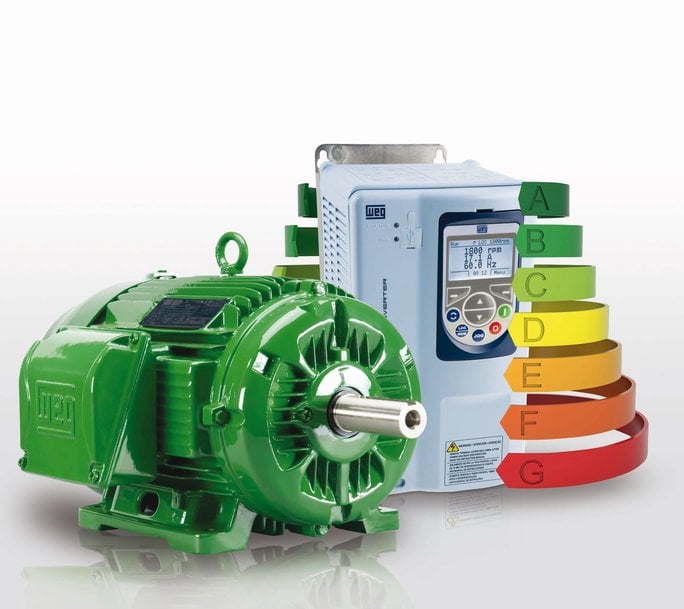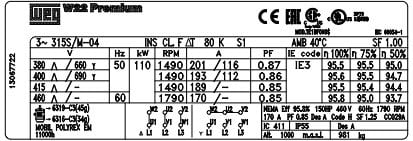www.industryemea.com
26
'22
Written on Modified on
Reading a motor nameplate
Why understanding motor data is key for efficient operation.

Electric motors sold in most countries are fitted with a nameplate displaying important operating data. Being able to read and understand these nameplates can help engineers select the most appropriate motor for an application, but they can be complex to decode. Here, Loic Kentrotis, marketing manager at leading motor manufacturer WEG France SAS discusses how motor nameplate information, along with the latest digital solutions can help to demystify motor data.
Motor nameplates can be found on most electric motors and contain the data and specifications needed to choose a suitable motor for an operation. Motor standards are set out by two main industry bodies depending on where the motor was manufactured — the International Electrotechnical Commission (IEC) and the National Electric Manufacturers Association (NEMA).
Having this technical information is not only crucial when making motor purchasing decisions, it can also help operators to get the most out of their motors. Additionally, it can allow engineers to better identify and solve any potential performance issues, thus improving overall operational efficiency and equipment longevity. It is also valuable when planning and carrying out important maintenance. Though nameplate format often varies between manufacturers and industry bodies, they will contain the same basic information. Let’s take a closer look at some of these data fields.
Phase
Often denoted by PH or ~, the phase refers to the type of power supply the motor is designed for and the number of power lines which supply it. Unless it is for a specialist application, it will usually be a single or three-phase motor.
Voltage
The voltage on the nameplate details the voltage at which the motor is designed to operate. Other parameters included on the nameplate such as power factor, torque, efficiency, and current are at rated voltage and frequency. Many industrial motors are designed to be run at more than one voltage, and this will be included on the nameplate. Most motors have a tolerance of 10 per cent either side of the stated voltage on the nameplate, but if it is used at other voltages this may negatively impact the motor performance.
Frequency
The frequency refers to the input frequency that the motor should run at and is usually 50 Hz or 60 Hz. If there are multiple frequencies, this must be noted on the nameplate, along with the parameters that will be altered at different frequencies.
Current
Current is measured in Amperes and noting any deviation from the specified current can help engineers to identify imbalance in phases or voltages that are different than they should be.
Revolutions per minute (speed)
The revolutions per minute (RPM) is the full load speed — the shaft speed at which the rated full-load output is produced and delivered.
Efficiency
The efficiency on the nameplate is the level at which the motor converts electrical input to mechanical output. This is useful when choosing a motor to ensure it operates at optimum efficiency, or when deciding whether to use a variable speed drive.
Service factor (S.F.)
The service factor on a nameplate is how much overload a motor can handle — for example, a motor with a 1.15 service factor can handle loads 15 per cent past its rated horsepower for temporary periods. This allows engineers to run the motor at safe loads to improve equipment efficiency and longevity.
Temperature ratings
The ambient temperature at which a motor can operate, and for how long, is indicated on the nameplate. Most motors are rated CONT, or continuous, to indicate that the load is constant during an indeterminate period of time. Though this information is important, there are additional considerations for motors operating at extreme temperatures — for motors required to withstand these conditions, contact WEG to ensure that you are using a suitable motor.
Though it is of course useful to know how to read a motor nameplate, WEG has developed an app to easily access motor data. WEG data viewer allows the user to immediately view the technical information of any low voltage WEG motor, anytime. By simply scanning a QR code, or by inputting the motor serial number, the user can find the motor nameplate, data sheets, technical drawings, performance curves, and the results of any electrical tests carried out on the motor.

The app gives WEG customers easy access to all the important technical details they may need, to simplify and improve operational routines. Having this information to hand also allows comparative analysis between equipment and can even make maintenance more straightforward, as all the key data is instantly accessible. There are plans to expand the app’s information offering in future too — updates will cover installation and operation manuals, catalogues and a wider range of test results.
Knowing and understanding technical specifications of motors can ensure optimum performance and efficiency, as well as safety and equipment longevity. Motor nameplates are an undoubtedly useful way to access product information, but WEG Data Viewer gives users a simpler and more sophisticated way of accessing all their motor data from one convenient platform.
www.weg.com

